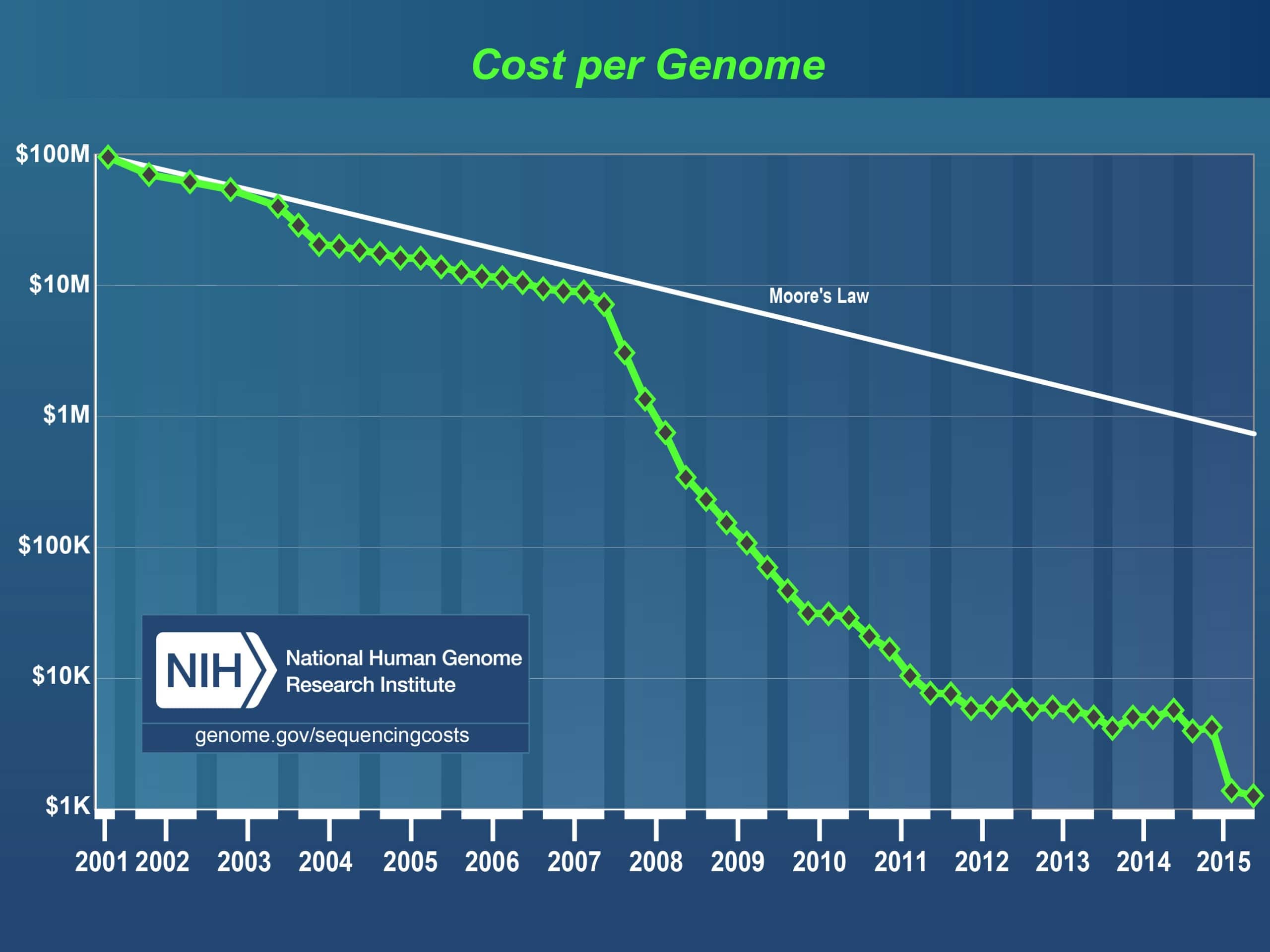Market Spotlight: The 2017 Market for NGS Informatics
Laboratories around the world are generating raw sequencing data at an unprecedented rate. Today it is possible to generate hundreds of millions of relatively short sequences in a single run in a short period of time with low per base cost. These technological developments have enabled widespread adoption of sequencing. At the same time, the challenges of aligning, analyzing, annotating and understanding the terabytes of data generated represent a major bottleneck in biological discovery and clinical adoption. Indeed, a plot of Moore’s Law compared to sequencing throughput shows the cost of DNA sequencing has declined much faster than the cost of disk storage and processing power.

Beating Moore’s Law
The 2017 Market for NGS Informatics: Probing the Commercial Landscape is the latest report from BioInformatics LLC designed to help companies understand these challenges from the perspective of NGS users. The scale of the data generated is not simply an obstacle for individual researchers trying to interpret it, but it presents significant informatics issues for reproducibility and even collaboration. NGS users are well aware that simply generating data does not lead to a proportionate increase in knowledge. They can also be excused for being overwhelmed by their range of choices as exemplified by the listing of over 3,000 sequencing analysis tools at the OMICtools website. Customer confusion isn’t helped by the non-stop flurry of new product releases, strategic alliances, investments and innovative start-ups.
A Flood of New Products
A quick scan of our executive newsletter Instrument Business Outlook, shows the dynamism of the market and the constant release of new products – here are a few that stood out to us:
SeraCare Life Science recently released the iQ NGS QC Management software v2, which supports whole-workflow data capture and includes integration with Illumina’s Basespace and LIMS. Seven Bridges announced in April that the Simons Genome Diversity Project dataset, which it called the largest dataset of human genetic variation ever collected, is now available for researchers via the Seven Bridges Platform.
Before that, TOMA Biosciences in March launched the COMPASS Tumor Profiling System, a workflow pathway from tumor, library preparation, sequencing, data analysis, clinical annotation and reporting that includes the TOMA OS-Seq, an oligo selective sequencing capture technology. Around the same time, Optra Health launched the iPhronesis Knowledge Automation for Clinical Genomics platform, using advanced neural language processing algorithms and deep machine learning. It is designed for rapid data curation, variant classification and clinical reporting.
In February, SYGNIS released the TrueHelix bioinformatics service platform for NGS, delivered through a dedicated web portal. The first service launched will be the TruePure tool for validating sample purity and checks for potential sample contamination. 10x Genomics then released a new software suite for analyzing and visualizing single-cell RNA sequencing data generated by its Chromium Single Cell 3’ Solution. It features the Loupe Cell Browser for identification of distinct cellular subpopulations, isolation of significant genes and measurement of expression levels.
In January, Pacific Biosciences released V2 of the chemistry and V4 of the software for its Sequel System, including a new version of SMRT Cells, which improves the mean read lengths to 10–18 kb and makes the System capable of loading 80 kb sequencing libraries. The release supports users’ ability to perform low-fold structural variant detection and key targeted sequencing applications. In the same month, Edico Genome, in a collaboration with Dell EMC, released in January the Edico Genome bundle, a pre-configured, out-of-the-box solution for rapid analysis and efficient storage of NGS data. Meanwhile, Cosmos ID announced in January that its automated metagenomics analysis solution is now a built-in feature of the Thermo Fisher Cloud.

Informatics Pain Points By Lab Throughput
(excerpt from BioInformatics LLC report)
A Web of Alliances
Alliances and consortia are a major element of the NGS informatics ecosystem. Naturally, much of the alliance activity revolves around Illumina. Illumina announced in April the donation of more than eight thousand associations of somatic genetic alterations to the Clinical Interpretation of Variants in Cancer resource, an openly accessible database hosted by Washington University in St. Louis and the company is now the largest donor. In March Illumina partnered with The Munich Leukemia Laboratory (MLL) and IBM Watson to build a new cognitive technology prototype that aims to help researchers improve leukemia treatment. MLL will use Illumina’s NovaSeq technology to sequence samples from its biobank of more than 500,000 cases. MLL researchers will use Watson to help interpret the genomic data alongside other data sources. The project intends to include innovative testing processes such as automated phenotyping and genotyping, including whole genome sequencing and RNA-Seq in 5,000 cases. MLL will utilize Illumina’s BaseSpace Informatics Suite, including BaseSpace Cohort Analyzer and BaseSpace Correlation Engine. In February, Illumina launched the iHope Network, a consortium of institutions committed to providing clinical whole-genome sequencing to underserved families. The consortium currently consists of Illumina, GGenome.One, GeneDx, HudsonAlpha and their affiliate healthcare partners. Members have committed to a minimum philanthropic donation of 10 whole-genome tests per year and the variants identified will be donated to public databases.
The beginning of 2017 saw Illumina announce a slew of new partnerships. The first was a strategic collaboration with Philips to integrate their respective sequencing systems and IntelliSpace Genomics clinical informatics platform for oncology, and coordinate marketing and sales of the resulting solutions. The solution will combine data from multiple sources, including IHC, digital pathology and lab tests, and deliver it in a dashboard view. The companies will also engage in clinical research collaborations with health systems. They also announced a partnership with IBM Watson Health to integrate IBM’s Watson for Genomics platform into its BaseSpace Sequence Hub and tumor sequencing process, including information to help interpret variant data produced by Illumina’s TruSight Tumor 170 panel. They entered into a co-marketing agreement with personalized medicine firm Kailos Genetics for the Kailos TargetRich line of research solutions for pharmacogenetics targets. The covered product lines are the TargetRich PGxComplete reagent and Kailos Blue data analysis solution. And in a move that surprised a number of analysts, Illumina and Bio-Rad Laboratories launched the Illumina Bio-Rad Single-Cell Sequencing Solution for high-throughput sequencing of thousands of individual cells. It consists of the ddSEQ Single-Cell Isolator and SureCell WTA 3’ Library Prep Kit. The workflow includes primary and secondary data analysis conducted via Illumina’s BaseSpace Informatics Suite.
But other players have been busy as well. In May, Bluebee and MediSapiens entered into a strategic partnership with a tailored end-to-end analytical solution for NGS data by integrating their respective Bluebee and Explorer platforms. Sarah Cannon, the Cancer Institute of Hospital Corporation of America, merged with Genospace in January to become a wholly owned subsidiary. The companies will harness and use molecular profiling data to more effectively match cancer patients to cutting edge therapies in clinical trials. The genomics data technology will be integrated into Sarah Cannon’s network of oncology programs across the US and UK.
WuXi NextCODE announced a partnership with the National Health Centre Singapore to advance population-based genomic research and precision medicine applications in Singapore, as part of a national precision medicine initiative. WuXi NextCODE will create a cloud-based enterprise data warehouse integrating large-scale whole-genome sequences, and medical and wearables data. They also entered into a long-term strategic alliance with AbbVie and Genomics Medicine Ireland to conduct population genomics research in Ireland aimed at advancing the discovery and development of novel therapeutic approaches to a range of serious diseases – a total of 45,000 genomes will be sequenced.
Investments in Innovation
As one would expect, the NGS data analysis space has caught the attention of investors. Last month, Genoox, which automates data interpretation and provides data points through a search engine, announced a $6 million investment by Inimiti Capital Partners and Glilot Capital Partners. Creathor Venture along with MedTech Innovation Partners, and existing investors Inventure and Pontos Group invested more than $16 million in Blueprint Genetics, a provider of clinical genetic testing for the diagnosis of inherited diseases that leveragings a proprietary AI-enabled sequencing and interpretation platform.
Congenica, a clinical genomics software for inherited diseases completed its Series B funding round with strategically important investors BGI Genomics (BGI), a recognized global leader in genomics, Healthlink Capital, another well-established China-based life-science investor and Future Planet Capital, a global innovation fund. Biomedical data analysis firm Seven Bridges invested in Spatial Transcriptomics, which develops tools for visualizing gene expression within tissue samples.
At the beginning of the year clinical genomics data analysis and reporting provider Omicia (renamed as Fabric Genomics) purchased Spiral Genetics to gain access to its tools for NGS variant detection, including its graph-based, population-specific reference genome and lossless data-compression technologies.
The scope and scale of sequencing projects will only continue to grow as throughput per platform increases and sequencing costs decrease. But continued advancements in sequencing technology are offset by the ability of scientists to interpret biologically or clinically relevant information. Industry can be expected to respond with ever more new product releases and alliances and VC dollars will continue to fuel innovation.
Please download an executive summary of The 2017 Market for NGS Informatics: Probing the Commercial Landscape to gain insights into the needs of end-users so that solutions to these many challenges can be overcome.




